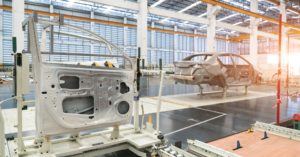We’ve learned a lot from the automakers when it comes to manufacturing efficiency. Our car-making forefathers took a long look at their production methods and figured out ways to increase value by making improvements in their processes. Today, printers, along with countless other industries, are realizing the benefits of implementing these concepts to improve their bottom lines.
It started with Henry Ford. He revolutionized the production process by using interchangeable parts, standardization, and what he’s best known for, the assembly line. By streamlining production, he was able to mass produce the Model T and make cars available to middle class families across America for the first time in 1908. By 1927, Ford had shipped 15 million cars, and the Model T came to symbolize a new method of manufacturing.
In the mid-21st century, Toyota engineers expanded on Ford’s ideas to become more market-focused. Their inspiration came from a supermarket model of inventory management where stores restock their shelves as products are purchased by shoppers. Applied to manufacturing, the concept of just-in-time inventory replenishment recognizes that more efficient inventory management results when customers “pull” products through the supply chain.
 According to Toyota’s website, the objective of its “Toyota Production System,” or TPS, is to serve its customers and employees while aligning with the company’s business goals. Central to the TPS are the principles of “Kaizen,” “Just in Time Manufacturing” and “Jidoka.” These values attempt to maximize efficiency and quality by using methods that simplify production flow and speed up response times. Production is driven by customer demand, and the way resources are allocated within the plant is known as “kanban.” All employees throughout the organization strive for continuous improvement in every aspect of the process.
According to Toyota’s website, the objective of its “Toyota Production System,” or TPS, is to serve its customers and employees while aligning with the company’s business goals. Central to the TPS are the principles of “Kaizen,” “Just in Time Manufacturing” and “Jidoka.” These values attempt to maximize efficiency and quality by using methods that simplify production flow and speed up response times. Production is driven by customer demand, and the way resources are allocated within the plant is known as “kanban.” All employees throughout the organization strive for continuous improvement in every aspect of the process.
Modern lean manufacturing is derived from the TPS and strives to eliminate all excess from a manufacturing system by focusing only on the things that add value. By removing the causes of “muri”,” or overburdening of people or equipment, and “mura,” or unevenness, the overall “muda,” or waste in the manufacturing process is reduced. (These terms were originally used in Japanese martial arts to protect the fighter by eliminating unnecessary movements!) In relation to manufacturing, seven deadly wastes (or mudas) have been identified:
- Transportation
- Inventory
- Motion
- Waiting
- Over-processing
- Over-production
- Defects
These activities take up time, resources and space and add no value in the eyes of the customer. The more these wastes can be minimized, the more dollars a manufacturer can wring out of the production process.
For several years, press builder Gallus has seen lean manufacturing concepts in the print industry “as a means of ensuring perfect job processing without sacrificing profit margins.” Through its “Smart Production Concept” program, Gallus helps its customers evaluate their print quality, production sequences and production environment to find opportunities to improve pressroom efficiency. The press manufacturer compares lean manufacturing to Formula 1 racing, where “a single second more or less at a pit stop can make the difference between winning and losing.”
We can learn a lot from our predecessors when it comes to many things, and manufacturing methods are no exception. Through the years, companies have continued to improve upon the basic concepts of production efficiency introduced by Henry Ford and Toyota. Today, printers and businesses across many industry sectors strive to adopt the principles of lean manufacturing in order to achieve the ultimate goal of maximizing value to customers and optimizing profits.

